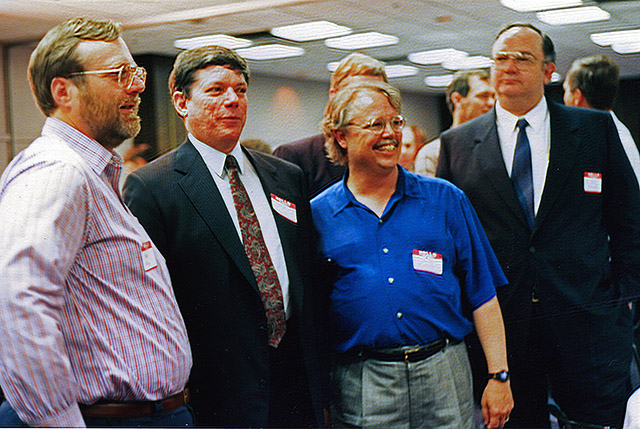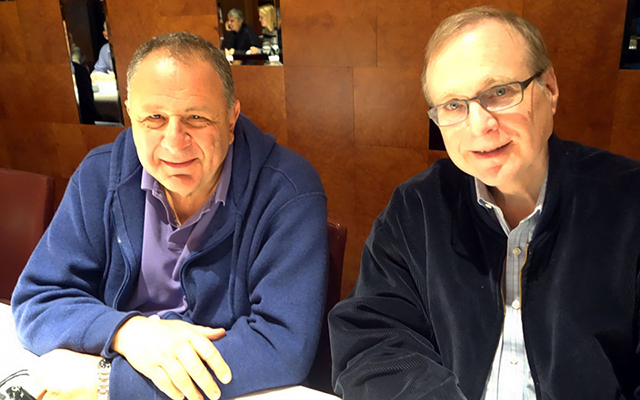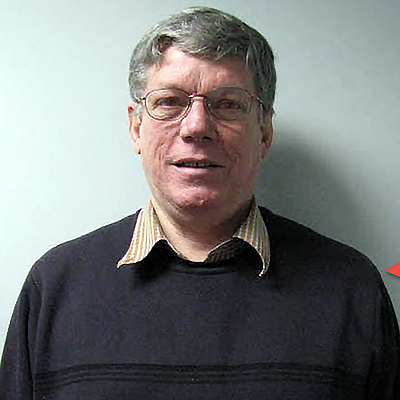The original Altair kit came with 128 bytes of memory, a mountain of plastic bags containing electronic/hardware components, multiple printed circuit boards and voluminous assembly and operating documents provided in multiple three-ring binders. Software was initially limited to an assembler, linker, etc., but not a higher-level language. It soon became apparent that a far greater market existed for assembled Altairs and every Altair would, sooner or later, inevitably host a copy of Microsoft BASIC. The development of documentation was in part overseen by David Bunnell who would later go on to launch several computer magazines including PC World and MAC World. David and I cofounded PC Magazine in 1981 which included plans for what became PC Week and PC Tech.
Paul was hired by Ed Roberts to run MITS’ software development group with his primary focus to be further enhancements and implementations of BASIC. His first task was to work on the initial version of MITS’ BASIC, known as “The 4K Basic,” and he quickly evolved this minimal version into Altair-compatible 4K, 8K and 12K versions, where 4K, 8K and 12K referred to the minimum amount of memory required for each and progressively more of a complete implementation of the BASIC language. It should be borne in mind that the 8080 was limited to a maximum of 64K of RAM and much of that would be required if significant applications were to be able to operate in such a restrictive memory constraint. Bill visited briefly in May of 1975 and worked with Paul and then returned to MITS that summer.
Paul’s role was extended to adding functionality to BASIC for the rapidly emerging array of hardware supported by the Altair, e.g., 8-inch floppies, 5 1/4-inch floppies, 10MB hard drives, and a variety of printers and other peripheral devices. Paul also did some early design work on the Altair II, which was to be a much advanced version of the Altair and was based on a CPU with writable control store, which meant instruction sets could be changed on the fly. During the day he typically worked on MITS software development and in the evenings on ports of BASIC for OEMs, stopping from time to time to play guitar.
Although I have always been a strong advocate for undergraduate and graduate degrees, I did strongly encourage Bill to move to Albuquerque and assured his dad that we would do our best to make the most of his dropping out of Harvard. Paul, as head of the MITS software development group, reported to me, but Bill did so only for a very brief period. The bulk of his time was occupied with developing OEM customers for BASIC, running Microsoft’s operation and doing contract negotiations, which we sometimes did jointly since MITS held an exclusive license for BASIC. However, the license had a provision that allowed Microsoft to sell BASIC licenses to OEMS that were not competing directly with Microsoft. A provision that was to cause some unhelpful complexity between the two companies from time to time.
One Friday afternoon, MITS received orders for five hundred assembled machines. Soon thereafter, IBM sent a number of lawyers to MITS to ask that MITS appear as a witness in an IBM antitrust case in which it was alleged that IBM dominated the world’s computer market. Their lawyers wanted to make the case that far more computers were being sold by MITS than IBM. MITS declined.
It soon became apparent that not every microcomputer running Microsoft BASIC was a result of having purchased it. Rampant copying caused a serious reduction in Microsoft royalties and as a result it was agreed every Altair sold without BASIC would also result in a royalty payment to Microsoft. Microsoft subsequently made this a contractual obligation of all licensees; a practice that years later was in part the basis, in principle at least, for the government’s antitrust case against Microsoft.
During his lifetime Paul Allen’s science, engineering, sports and societal investments have continued to make significant contributions in each of these fields. But, arguably, by far his greatest contribution was his software development work, in concert with Bill and others, in rapidly creating multiple, robust versions of BASIC for virtually all of the 8080 hardware architectures. Microsoft’s price for a fully paid OEM source license was $250,000. Every microcomputer OEM soon realized that including BASIC was an absolute requirement, but they did not have the software expertise required to implement BASIC on their machines and this would result in frantic calls to Microsoft asking if they, in this case Paul and his team of developers, could do the port for an additional fee.


MITS Reunion Photo: Paul Allen. Eddie Currie, David Bunnell, Ed Roberts
In 1979, Microsoft moved to Bellevue, Washington, on the eighth floor of a bank building. The corporate office had formerly been on the eighth floor of a bank building in Albuquerque. By then, BASIC for the Altair was robust and required relatively little Microsoft support. And Paul turned his attention to development of a 16-bit version of BASIC for the Intel 8086 and other development. As Microsoft grew, Paul seemed to find less and less participation in some of the visionary aspects of Microsoft and when he developed non-Hodgkin’s lymphoma disease he left Microsoft to seek treatment and pursue philanthropic and business opportunities. The profound difference in Paul’s personality, which was soft-spoken and low-key, versus Bill’s, which could be loud, combative and confrontational, compounded the difficulty for Paul. Microsoft appeared to taking flight without him in the cockpit.
The myriad OEM licenses and associated porting fees served as Microsoft’s vital cash cow for many years and, perhaps more importantly, allowed Microsoft to develop crucial commercial relationships with virtually every microcomputer manufacture in the world. Literally every microcomputer, reqardless of manufacturer would use some form of Microsoft BASIC, and Microsoft quickly became a household brand name. Inevitably, OEMs would return to Microsoft again and again to fulfill their software needs. Even IBM, in 1981, looked to Microsoft to provide not only languages such as BASIC but also a “Windows” environment and a huge array of application software. Microsoft was destined to remain virtually the “only game in town” for many years, and due largely to the efforts of Paul Allen. Without its industry dominance, Microsoft may well have not survived. And it was BASIC that was to be the only truly in-house software product created entirely by Microsoft, for many, many years.
It was Microsoft’s phenomenal success, early in the evolution of the microcomputer, that made it possible for Paul to make so many other significant contributions to the world, and that success may well have never occurred without Paul’s ability to deliver on the dream to supply the software for all of the microcomputers in the world, beginning with BASIC, and to do so in the early days of the industry. Those at MITS who knew Paul always referred to him as a brilliant polymath and a true gentleman. His quiet, easy going manner, great sense of humor, love of music, guitars, software in all of its forms, compassion and concern for others, together with a totally committed work ethic served as a great role model at MITS.


